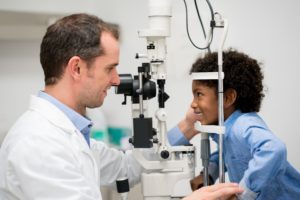March 15, 2021
By Dwight Akerman, OD, MBA, FAAO
 Due to the urgency of the increasing prevalence of myopia worldwide, the European Society of Ophthalmology, in cooperation with the International Myopia Institute, published a review article to increase awareness among eye care professionals and provide recommendations to prevent the development and progression of myopia in children and adolescents.
Due to the urgency of the increasing prevalence of myopia worldwide, the European Society of Ophthalmology, in cooperation with the International Myopia Institute, published a review article to increase awareness among eye care professionals and provide recommendations to prevent the development and progression of myopia in children and adolescents.
Based on the IMI White Papers, this review paper makes several specific conclusions regarding interventions for controlling myopia:
- Environmental influences: Indoor near work and outdoor activity play important roles in developing myopia and preventing myopia, respectively. There is strong evidence that less near work and more outdoor activity protect against myopia development in the human eye. Time outdoors itself, rather than physical activity, has been suggested to be the protective factor. The link between time outdoors in the prevention of myopia is stronger than the link between time outdoors and slowing the progression of existing myopia.
- Contact lenses: Ineffective—rigid gas permeable contact lenses showed inconsistent results in myopia progression (very low-certainty evidence). Comparing spherical aberration SCLs with single vision SCLs reported no difference in myopia (refractive) progression nor axial length elongation (low-certainty evidence).
- Contact lenses: Effective—axial elongation was slightly less for bifocal SCL wearers than for single vision SCL wearers (low-certainty evidence). Orthokeratology contact lenses were more effective than SVLs in slowing axial elongation (moderate-certainty evidence). There is evidence of myopia control with soft multifocal contact lenses (low-certainty evidence), specific myopia control soft lens designs (moderate-certainty evidence), and orthokeratology (moderate-certainty evidence).
- Pharmaceutical agents: Antimuscarinic eye drugs such as atropine eye drop or pirenzepine eye gel may slow the progression of myopia (moderate-certainty evidence). Axial elongation was lower for children treated with atropine than those treated with placebo (moderate-certainty evidence) in studies using higher doses. However, there is a weaker association between refractive error and axial length changes than optical studies. According to Cochrane summary, systematic seven-methylxanthine had a small effect on myopic progression and axial elongation compared with placebo in one study (moderate-certainty evidence). One study did not find slowed myopia progression when comparing timolol eye drops with no drops (low-certainty evidence).
- Combination therapies: Myopia progression was slower in children treated with combinations of atropine eye drops and multifocal spectacles than in children treated with placebo eye drops and single vision lenses (moderate-certainty evidence). Orthokeratology with low-dose atropine improved myopia control by the synergistic effect compared with orthokeratology treatment alone. Further studies are needed to fully assess the efficacy and safety of atropine and orthokeratology or bi- or multifocal soft contact lens combination therapy.
The authors conclude by reminding eye care professionals that myopia information is continually evolving, so it is essential to stay abreast of studies published in the peer-reviewed literature.
Abstract
Update and guidance on management of myopia. European Society of Ophthalmology in cooperation with International Myopia Institute
Németh, J., Tapasztó, B., Aclimandos, W. A., Kestelyn, P., Jonas, J. B., De Faber, J. T. H., … & Resnikoff, S.
The prevalence of myopia is increasing extensively worldwide. The number of people with myopia in 2020 is predicted to be 2.6 billion globally, which is expected to rise up to 4.9 billion by 2050 unless preventive actions and interventions are taken. The number of individuals with high myopia is also increasing substantially, and pathological myopia is predicted to become the most common cause of irreversible vision impairment and blindness worldwide, and also in Europe. These prevalence estimates indicate the importance of reducing the burden of myopia by means of myopia control interventions to prevent myopia onset and to slow myopia progression. Due to the urgency of the situation, the European Society of Ophthalmology decided to publish this update of the current information and guidance on management of myopia. The pathogenesis and genetics of myopia are also summarized and epidemiology, risk factors, preventive and treatment options are discussed in detail.
Németh, J., Tapasztó, B., Aclimandos, W. A., Kestelyn, P., Jonas, J. B., De Faber, J. T. H., … & Resnikoff, S. (2021). Update and guidance on management of myopia. European Society of Ophthalmology in cooperation with International Myopia Institute. European Journal of Ophthalmology, 1120672121998960.
DOI: https://doi.org/10.1177/1120672121998960













